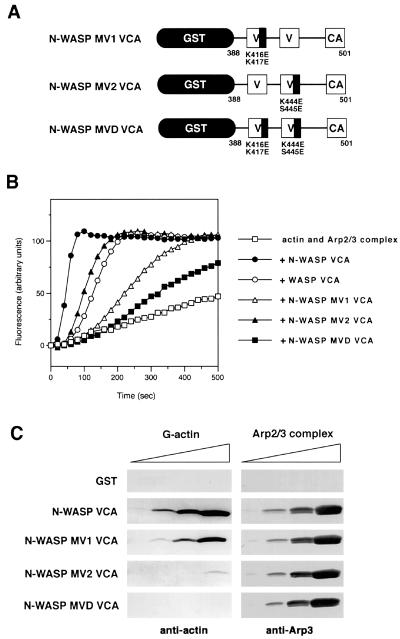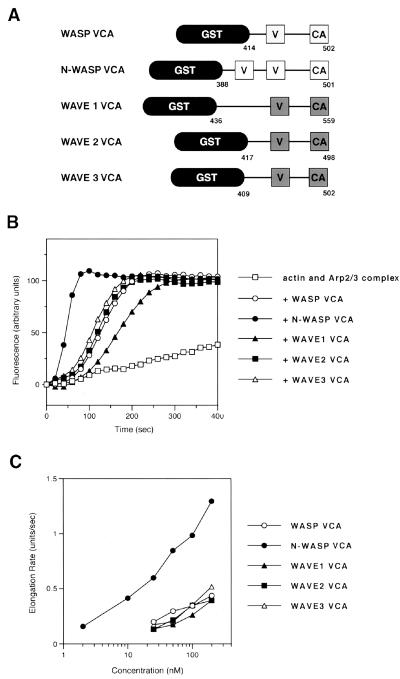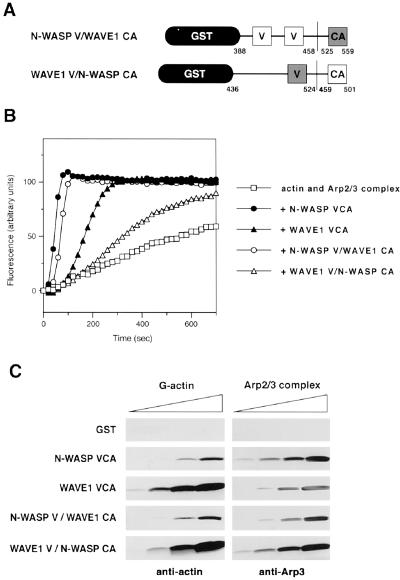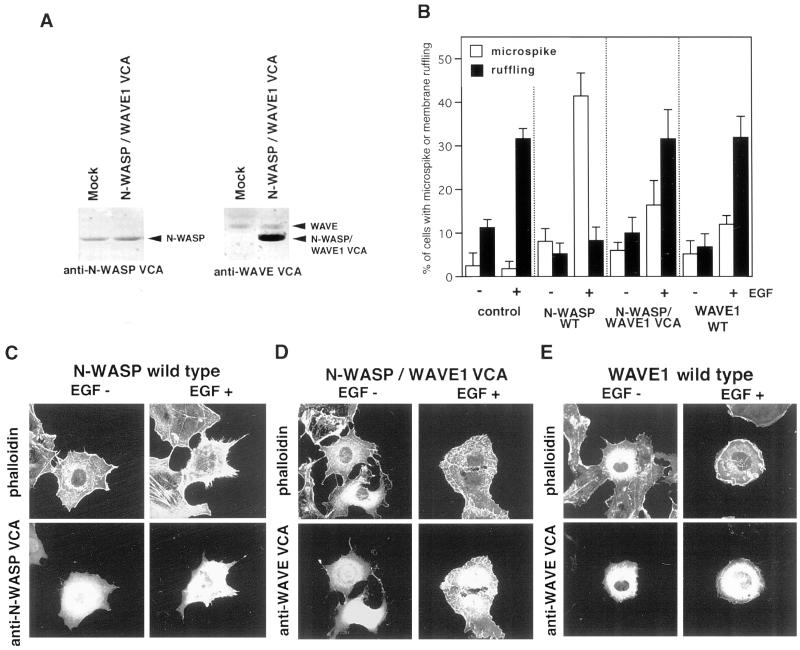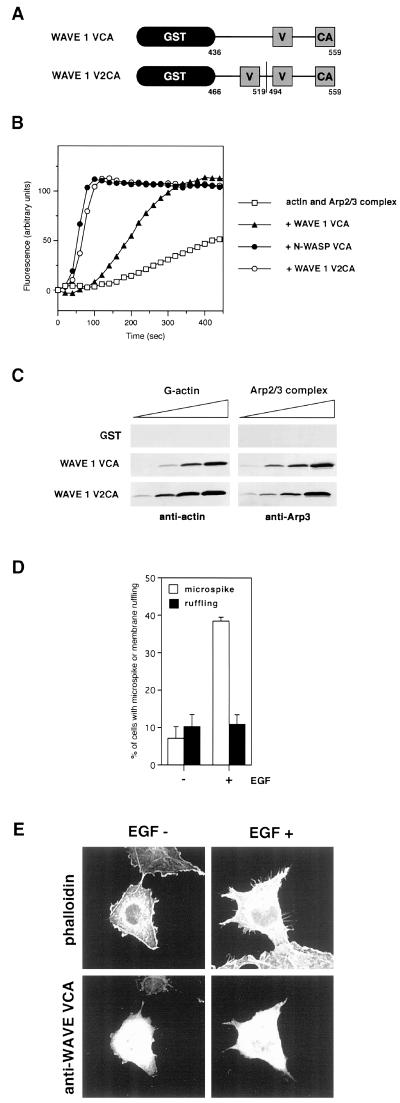Abstract
All WASP family proteins share a common C terminus that consists of the verprolin homology domain (V), cofilin homology domain (C), and acidic region (A), through which they activate Arp2/3 complex-induced actin polymerization. In this study, we characterized the Arp2/3 complex-mediated actin polymerization activity of VCA fragments of all of the WASP family proteins: WASP, N-WASP, WAVE1, WAVE2, and WAVE3. All of the VCA fragments stimulated the nucleating activity of Arp2/3 complex. Among them, N-WASP VCA, which possesses two tandem V motifs, had a more potent activity than other VCA proteins. The chimeric protein experiments revealed that the V motif was more important to the activation potency than the CA region; two V motifs were required for full activity of N-WASP. COS7 cells overexpressing N-WASP form microspikes in response to epidermal growth factor. However, when a chimeric protein in which the VCA region of N-WASP is replaced with WAVE1 VCA was overexpressed, microspike formation was suppressed. Interestingly, when the N-WASP VCA region was replaced with WAVE1 VCA, having two V motifs, this chimeric protein could induce microspike formation. These results indicate that strong activation of Arp2/3 complex by N-WASP is mainly caused by its two tandem V motifs, which are essential for actin microspike formation.
The actin cytoskeleton plays crucial roles in a large number of cellular processes such as motility and cytokinesis (1–3). In each of these processes, the actin cytoskeleton is dynamically reorganized in response to extracellular stimuli. Therefore, the signaling mechanisms that link extracellular stimuli to the assembly and disassembly of the actin cytoskeleton have been of intense interest. The Rho family of small GTPases, including Cdc42, Rac, and Rho, have been implicated in such signaling pathways (4, 5). However, the molecular mechanisms by which Rho family proteins induce reorganization of the actin cytoskeleton are not fully understood. Recently, WASP (Wiskott–Aldrich syndrome protein) family proteins were identified as key molecules linking Cdc42- and Rac-dependent signals to filopodium and lamellipodium formation, respectively (6–9).
The mammalian WASP family consists of five members: WASP, N-WASP, WAVE1, WAVE2, and WAVE3. WASP was first identified as the product of the gene whose mutation causes the human hereditary disease, Wiskott–Aldrich syndrome (10), an X-linked disease characterized by platelet deficiency, immunodeficiency, and eczema (11). We identified a WASP-related protein as a Grb2/Ash binding protein and named it neural-WASP (N-WASP) (12). We next found WAVE1 (WASP family verprolin homologous protein 1) (13) and its homologues, WAVE2 and WAVE3 (14). It was found that N-WASP functions in the formation of microspike downstream of Cdc42 (15), whereas WAVE1 is essential for the induction of membrane ruffling by Rac (13).
All WASP family proteins have a common C-terminal motif, which consists of the verprolin homology domain (V), cofilin homology domain (C), and acidic region (A). The V region binds to monomeric actin (G-actin) (16), and the CA region binds to Arp2/3 complex (17), which is composed of seven subunits including actin-related proteins 2 and 3 (18, 19). Arp2/3 complex has been shown to promote actin nucleation and binds to the pointed end and side of the actin filament (20, 21). Recently, the VCA regions of WASP, N-WASP, and WAVE1 have been shown to stimulate actin-nucleation and polymerization through Arp2/3 complex activation (22–24). In this case, stimulated by VCA, the Arp2/3 complex is thought to nucleate and assemble actin filaments. Thus, the VCA regions in all WASP family proteins play a pivotal role in the regulation of the actin cytoskeleton thorough the Arp2/3 complex. Despite the importance of the VCA region, its comparative behavior in WASP family proteins has not been studied.
We characterize here the role of the VCA regions of all mammalian WASP family proteins in Arp2/3 complex-mediated actin polymerization activity. We found that the N-WASP VCA, which has two tandem V motifs, has the strongest activity to induce actin polymerization, which is necessary for induction of actin-microspike formation by N-WASP.
Experimental Procedures
Purification of Actin, Arp2/3 Complex, and Glutathione S-Transferase (GST) Fusion Proteins.
Actin was purified from rabbit skeletal muscle, and monomeric actin was isolated by gel filtration on Superdex 200 (Amersham Pharmacia) in G buffer (2 mM Tris⋅HCl, pH 8.0, 0.2 mM CaCl2, 0.5 mM DTT, 0.2 mM ATP). Bovine Arp2/3 complex was purified according to a published protocol (25). GST fusion proteins were expressed in Escherichia coli and purified as described previously (12). All proteins were quantitated by the Bradford assay (Bio-Rad) using BSA as a standard.
Construction of Various Mutants.
A DNA fragment encoding N-WASP VCA () was obtained by PCR using rat N-WASP cDNA (26) as a template. This fragment was then subcloned into pGEX-2T (Amersham Pharmacia) to obtain GST fusion protein. Other WASP family VCAs have been constructed previously (13, 14, 27). For construction of N-WASP V/WAVE1 CA and WAVE1 V/N-WASP CA, the DNA fragments encoding the N-WASP V () and WAVE1 CA () or WAVE1 V () and N-WASP CA () were amplified by PCR, respectively. Each set of fragments was ligated and then subcloned into pGEX-2T. N-WASP MV1, MV2, and MVD VCAs were prepared as follows. The point mutations shown in Fig. 3A were introduced by PCR using mutated oligonucleotide primers, and the amplified fragments were inserted into pGEX-2T. For construction of chimeric full-length mutant (N-WASP/WAVE1 VCA), DNA fragments encoding the N-WASP N terminus () and WAVE1 VCA (), which had been amplified by PCR, were ligated and subcloned into pcDL-SRαII mammalian expression vector. For construction of WAVE1 V2CA, the DNA fragments encoding WAVE1 () and () were amplified by PCR, ligated, and subcloned into pGEX-2T. This DNA fragment encoding WAVE1 V2CA was ligated to the DNA fragment encoding the N-WASP N terminus () and subcloned into pcDL-SRαII for construction of the N-WASP/WAVE1 V2CA mutant. The nucleotide sequences of all mutants were confirmed.
Figure 3.
Two V motifs of N-WASP VCA are required for its full activity. (A) Schematic structures of N-WASP MV1, MV2, and MVD VCAs. (B) The effect of mutation in V motif on actin polymerization. Actin polymerization was followed in the presence of MV1, MV2, or MVD VCAs (100 nM). (C) The ability of MV1, MV2, and MVD VCAs to bind G-actin and Arp2/3 complex. MV1, MV2, and MVD VCAs were immobilized on beads and incubated with G-actin or Arp2/3 complex. Bound proteins were analyzed by Western blotting.
Actin Polymerization Assays.
Actin polymerization was measured as described previously (23). Actin was labeled with N-(1-pyrenyl)iodoacetamide (Molecular Probes) according to an established protocol (28). Briefly, 60 nM Arp2/3 complex and GST fusion protein were preincubated for 5 min in XB (10 mM Hepes, pH 7.6/100 mM KCl/1 mM MgCl2/0.1 mM EDTA/1 mM DTT). The reaction was started by adding 2.2 μM actin (2.0 μM unlabeled actin and 0.2 μM pyrene-labeled actin), and fluorescence change was measured at 407 nm with excitation at 365 nm in a fluorescence spectrometer (Jasco, Tokyo). All kinetic analyses were performed using the software provided with the spectrometer.
Binding Assays.
Equal amounts of GST fusion proteins were immobilized on glutathione–Sepharose beads (Amersham Pharmacia) and incubated with monomeric actin in G-buffer containing 0.1% Triton X-100 or with Arp2/3 complex in XB plus 0.1% Tween 20. After gentle mixing for 2 h at 4°C, the beads were washed three times with the buffer used for incubation. Proteins bound to the beads were eluted with SDS sample buffer and analyzed by Western blotting using anti-actin antibody (Chemicon) or anti-Arp3 antibody (27).
Transient Expression in COS7 Cells.
Recombinant plasmids for expression of wild-type N-WASP, wild-type WAVE1, N-WASP/WAVE1 VCA, and N-WASP/WAVE1 V2CA, which were constructed in pcDL-SRαII mammalian expression vector, were prepared from Escherichia coli using a plasmid Midi kit (Qiagen, Chatsworth, CA). COS7 cells were transfected with these plasmids by electroporation and subjected to immunofluorescence microscopy or Western blotting as described previously (12). Anti-N-WASP VCA antibody (12) and anti-WAVE VCA antibody (13) were used as primary antibodies. For the stimulation with epidermal growth factor (EGF), the transfected cells were starved for 15 h before treatment with 100 ng/ml human EGF (GIBCO/BRL) for 10 min.
Results
Among All of the VCA Regions in WASP Family Members, the N-WASP VCA Activates Arp2/3 Complex Most Effectively.
WASP family proteins share a common C-terminal motif (VCA). Among them, WASP, N-WASP, and WAVE1 have been shown to activate Arp2/3 complex through the VCA region, which is the minimum essential site for the activation.
To compare the activation potency of the VCAs, we first generated GST fusion VCA fragments of all WASP family proteins and characterized their ability to stimulate Arp2/3 complex-mediated actin polymerization (Fig. 1A). Polymerization kinetics was monitored using the pyrene actin assay in which an increase in fluorescence intensity indicates actin polymerization. All GST–VCA proteins accelerated actin polymerization in the presence of Arp2/3 complex, reducing the lag time in polymerization and increasing the maximum rate of elongation (Fig. 1B). Among these GST–VCA proteins, N-WASP VCA, which has two tandem V motifs, induced the fastest actin polymerization. GST–VCAs of WASP, WAVE2, and WAVE3 moderately increased the rate of actin polymerization. However, WAVE1 VCA was found to be the weakest activator for Arp2/3 complex. To assess the difference in the activity more quantitatively, we measured concentration-dependent activation curves for these VCAs (Fig. 1C). From these curves, it was confirmed that N-WASP VCA is the most potent activator for Arp2/3 complex-induced actin polymerization among WASP family VCAs, the other VCAs requiring approximately 10- to 20-fold more amounts to obtain the same activity as N-WASP VCA. These results show that VCA regions of all WASP family proteins can induce actin polymerization by stimulating actin-nucleating activity of Arp2/3 complex and that N-WASP VCA has the strongest activity.
Figure 1.
Comparison of Arp2/3 complex-mediated actin polymerization activity of WASP family VCAs. (A) Schematic structures of WASP family VCAs. VCA regions of WASP family proteins were constructed as GST fusion proteins. The numbers shown in the figure refer to those of amino acid residues in the full-length protein. V, verprolin homology domain; CA, cofilin homology domain and acidic region. (B) Actin polymerization was followed in the presence of 100 nM VCAs using pyrene actin. Fluorescence intensity is given in arbitrary units. (C) Dose-response curve showing the change in the maximum rate of filament elongation as a function of increasing concentrations of VCAs.
V Motif Is the Determinant for the Actin Polymerization Activity.
To identify which domain of VCA, the V motif that binds to G-actin or the CA region that binds to Arp2/3 complex, is most responsible for the strongest activity of N-WASP, we generated chimeric VCA in which the V motif of N-WASP is attached to CA of WAVE1 (N-WASP V/WAVE1 CA), or vice versa (WAVE1 V/N-WASP CA), and tested the activity (Fig. 2 A and B). The activity of N-WASP V/WAVE1 CA was not significantly different from that of wild-type N-WASP VCA. In contrast, WAVE1 V/N-WASP CA showed a markedly weaker activity.
Figure 2.
V motif is the determinant of the actin polymerization activity of VCA. (A) Schematic structures of chimeric VCAs. (B) Actin polymerization stimulated by chimeric VCAs (100 nM). (C) Binding of G-actin and Arp2/3 complex to wild-type and chimeric VCAs. The GST fusion proteins were tested for their ability to pull-down either G-actin or Arp2/3 complex from solution. Final concentrations of G-actin were 0.06, 0.28, 1.4, and 7 μM, and those of Arp2/3 complex were 2, 10, 50, and 250 nM. The bound proteins were analyzed by Western blotting with anti-actin and anti-Arp3 antibodies.
We next determined the ability of various GST–VCA proteins to bind G-actin and Arp2/3 complex. As shown in Fig. 2C, N-WASP V bound to G-actin less effectively than WAVE1 V, whereas the binding of N-WASP CA to Arp2/3 complex was stronger than that of WAVE1 CA. These binding properties of the V and CA regions of N-WASP and WAVE1 were retained in chimeric VCAs. The chimeric protein of N-WASP V and WAVE1 CA showed weak actin binding and Arp2/3 complex binding activity. However, the chimeric protein of WAVE1 V and N-WASP CA had strong activity for both G-actin and Arp2/3 complex. This result excludes the possibility that the change of chimeric VCA activity is caused by the loss or gain of capacity to bind G-actin and Arp2/3 complex during chimerization. We concluded that the V motif, rather than CA region, is the determinant for actin polymerization activity.
Two V Motifs in N-WASP VCA Are Required for Its Full Activity.
We suspected that the highest activity of N-WASP VCA was attributable to two tandem V motifs, which only exist in N-WASP among WASP family proteins. To test this notion, we introduced point mutations in the V motif of N-WASP VCA to inactivate it. In yeast verprolin and its human homologue WIP (WASP-interacting protein), which are actin binding proteins having a V motif, the sequence KLKK in the V motif seems to be critical for actin binding. The mutation of this sequence (KLKK to KLAA or KLEE) has been shown to abolish the interaction of the V motif with actin (29, 30). Based on this fact, we generated three mutants of N-WASP VCA, MV1, MV2, and MVD (Fig. 3A). QLKK (414) in the N-terminal V motif was changed to QLEE in MV1 VCA mutant, and QLKS (442) in the C-terminal V motif was mutated to QLEE in MV2 VCA. MVD VCA mutant has both mutations.
As shown in Fig. 3B, the activity of both MV1 VCA and MV2 VCA was reduced as compared with that of the wild-type N-WASP VCA, and the reduction was more prominent in MV1 VCA than in MV2 VCA. MVD VCA showed much weaker activity than MV1 VCA. The activity of MV2 VCA was similar to that of other WASP family VCAs, which possess only one V motif. These results clearly indicate that two V motifs in N-WASP VCA are necessary for its full activity.
Next, we examined the ability of these mutants to interact with G-actin and Arp2/3 complex (Fig. 3C). The association between these mutants and Arp2/3 complex was unchanged. On the other hand, G-actin binding activity was reduced in all mutants. Although the capacity of MV2 VCA to bind G-actin was more markedly decreased than that of MV1 VCA, actin polymerization activity was diminished much more in MV1 VCA. Binding of MVD VCA to G-actin could not be detected in this binding assay. These results suggest that there is no direct correlation between the G-actin binding ability and the potency of Arp2/3 complex activation.
Strong Activity of N-WASP VCA Is Indispensable for Actin–Microspike Formation.
To examine the relation between the actin polymerization activity of VCA protein in vitro and function in vivo, we constructed a full-length chimeric protein (N-WASP/WAVE1 VCA) in which VCA of N-WASP is replaced with WAVE1 VCA. We then expressed wild-type N-WASP, N-WASP/WAVE1 VCA, and wild-type WAVE1 in COS7 cells. Chimerization was confirmed by Western blotting in which N-WASP/WAVE1 VCA was recognized by antibody against WAVE1 VCA but not by antibody against N-WASP VCA (Fig. 4A). Under EGF stimulation, 2% and 32% of untransfected cells formed microspikes and membrane ruffles, respectively (Fig. 4B). On the other hand, 41% of cells overexpressing wild-type N-WASP formed microspikes in response to EGF (Fig. 4 B and C). Using time-lapse video microscopy, we confirmed that these projections on the cell surface are not retraction fibers but protruding microspikes (data not shown). When N-WASP/WAVE1 VCA was overexpressed, the proportion of cells with microspikes was reduced to 16%. Instead, 32% of the cells formed membrane ruffles (Fig. 4 B and D), although they were morphologically different from those of untransfected and WAVE1 transfected cells. In cells overexpressing N-WASP/WAVE1 VCA, ruffles were seen not only in the cell periphery but also in the dorsal surface of the plasma membrane, whereas peripheral membrane ruffles were mainly observed in untransfected and WAVE1 transfected cells (Fig. 4E). Among cells overexpressing wild-type WAVE1, the proportion of cells with membrane ruffles was 32% (Fig. 4B). Taken together, these results suggest that the strong activation of Arp2/3 complex by N-WASP VCA is critical for actin–microspike formation induced by N-WASP.
Figure 4.
N-WASP VCA is necessary for actin–microspike formation induced by N-WASP. (A) Confirmation of chimerization. Cell lysates of COS7 cells overexpressing wild-type N-WASP and N-WASP/WAVE1 VCA were subjected to Western blotting with anti-N-WASP VCA and anti-WAVE1 VCA antibodies. (B) Quantitation of microspike and membrane ruffle formation. Transfected cells were serum-starved and then stimulated with or without EGF for 10 min. The percentage of cells forming microspikes or membrane ruffles was calculated among transfected cells. Error bars represent the standard deviation of three different determinations. At least 50 cells were counted in each determination. (C–E) Immunofluorescence staining of transfected cells. Cells were stained with phalloidin to visualize actin filaments and antibody against N-WASP VCA or WAVE1 VCA to detect ectopically expressed proteins.
Addition of Another V Motif to WAVE1 VCA Increases Its Activity.
To verify whether the number of V motifs determines the extent of actin polymerization activity, we generated a WAVE1 VCA mutant (WAVE1 V2CA), which has two tandem WAVE1 V motifs like N-WASP VCA, by adding another V motif to WAVE1 VCA (Fig. 5A). As shown in Fig. 5B, WAVE1 V2CA more potently stimulated Arp2/3 complex and induced actin polymerization faster than wild-type WAVE1 VCA. The activity of WAVE1 V2CA was almost the same level as that of N-WASP VCA. The G-actin binding activity of WAVE1 V2CA was also increased as compared with that of wild-type WAVE1 VCA, whereas the Arp2/3 complex binding activity was unchanged (Fig. 5C).
Figure 5.
Addition of another V motif to WAVE1 VCA increases its activity. (A) Schematic structure of WAVE1 V2CA. (B) The effect of addition of another V motif to WAVE1 VCA on actin polymerization. Actin polymerization was stimulated by WAVE1 V2CA (100 nM). (C) The ability of WAVE1 V2CA to bind G-actin and Arp2/3 complex. WAVE1 V2CA was immobilized on beads and incubated with G-actin or Arp2/3 complex. Bound proteins were analyzed by Western blotting. (D) COS7 cells overexpressing N-WASP/WAVE1 V2CA were stimulated with EGF, and morphological change was quantitated as described in Fig. 4B. (E) Immunofluorescence staining of cells transfected with N-WASP/WAVE1 V2CA. Cells were stained with phalloidin and antibody against WAVE1 VCA.
Next, we determined whether the actin polymerization activity of WAVE1 V2CA is strong enough to induce microspike formation. We generated a full-length chimeric protein (N-WASP/WAVE1 V2CA) by substituting the VCA region of N-WASP with WAVE1 V2CA and expressed it in COS7 cells. When treated with EGF, 38% of transfected cells formed microspikes, a result that we confirmed by using time-lapse video microscopy, whereas 11% formed membrane ruffles (Fig. 5 D and E). This morphological effect of N-WASP/WAVE1 V2CA was nearly identical to that of wild-type N-WASP shown in Fig. 4 B and C. These results indicate that two V motifs in the VCA region, even if they are the WAVE1 V motifs, are sufficient for rapid actin polymerization, which can lead to microspike formation in vivo.
Discussion
In this study, we showed that the C-terminal fragments of all WASP family proteins including WAVE2 and WAVE3 have an ability to activate Arp2/3 complex and to induce rapid actin polymerization in vitro (Fig. 1B). Bee1/Las17p, a yeast WASP homologue, also has been shown to activate Arp2/3 complex in vitro (31). Thus, this activity to enhance actin nucleation by Arp2/3 complex is conserved among all WASP family proteins. However, there is a quantitative difference in the activity among the proteins. The VCA region of N-WASP had the strongest potency to induce rapid actin polymerization.
Analysis using a chimeric VCA proteins of N-WASP and WAVE1 revealed that the V motif determines the activation potency for Arp2/3 complex-mediated actin polymerization. The V motif is the direct binding site for G-actin, and its deletion has been shown to result in the loss of in vivo functions of N-WASP and WAVE1 (13, 16). Thus, the V motif in WASP family proteins is thought to be essential for their function to induce actin polymerization.
Among WASP family proteins, only N-WASP possesses two tandem V motifs. However, the importance of the tandem repeats in the function of N-WASP had not been determined. In this study, we demonstrated that both of the V motifs were required for the rapid actin polymerization by N-WASP VCA. Furthermore, the WAVE1 V2CA mutant, which has two tandem WAVE1 V motifs, induced rapid actin polymerization as well as did N-WASP VCA. How do the two V motifs in the VCA region cause rapid actin polymerization? Mutation in either V motif of N-WASP VCA decreased its interaction with G-actin (Fig. 3C). Additionally, the association of WAVE1 V2CA with G-actin increased as compared with that of wild-type WAVE1 VCA, which has only one V motif (Fig. 5C). These results suggest that two V motifs enable the VCA region to interact with G-actin at two sites, resulting in an increase in the capacity to bind G-actin. However, we could not find any relation between the binding ability for G-actin and the actin polymerization activity in various VCAs. For example, although N-WASP MV1 VCA binds to G-actin more effectively than MV2 VCA, the actin polymerization activity of MV1 VCA was weaker than that of MV2 VCA (Fig. 3 B and C). Considering this result, it is the stoichiometry of G-actin association, and not the affinity for G-actin, that seems most important in the stronger activation of Arp2/3 complex. The molecular mechanism by which two V motifs contribute to polymerization remains to be elucidated. A structural study of the VCA region complexed with G-actin and/or Arp2/3 complex may be required to elucidate the activation mechanism.
We also found that two tandem V motifs in N-WASP are necessary for its induction of microspikes. In addition, chimeric protein, which consists of the N-WASP N terminus and WAVE1 V2CA possessing two WAVE1 V motifs, was capable of inducing microspikes. Microspikes are protrusive structures that contain a tight bundle of parallel actin filaments, whose formation is driven by rapid actin polymerization (2). Membrane ruffles, another well known protrusive structure, are also caused by actin polymerization (32), but the organization of actin filaments is quite different from that of microspikes. Membrane ruffles contain a branched meshwork of actin filaments (33–35). In microspikes, actin filaments exist more densely to form a tight bundle than in membrane ruffling (36). Thus, it is possible that microspike formation requires more actin-nucleation in a restricted area. Therefore, the strong activation of Arp2/3 complex caused by two tandem V motifs may be important for such a specific assembly of actin filaments in microspikes. Further studies will be required to identify the mechanism by which two V motifs affect actin assembly in microspike formation.
In conclusion, we revealed the importance of two tandem V motifs for a strong activation of Arp2/3 complex and induction of microspike formation by N-WASP. This finding will increase our understanding of the mechanism of filopodium formation, which is one of the most important events in cell locomotion.
Acknowledgments
We thank Dr. Toshihiko Suzuki and Dr. Chihiro Sasakawa (Institute of Medical Science, University of Tokyo) for providing antibody against Arp3. This study was supported in part by a grant-in-aid for Cancer Research from the Ministry of Education, Science, and Culture of Japan and by a grant-in-aid for Research for the Future Program from the Japan Society for the Promotion of Science. We also thank the National Institute of General Medical Sciences for support.
Abbreviations
- WASP
Wiskott–Aldrich Syndrome Protein
- WAVE
WASP family verprolin homologous protein
- VCA
verprolin, cofilin homology and acidic region
- GST
glutathione S-transferase
- EGF
epidermal growth factor
Footnotes
Article published online before print: Proc. Natl. Acad. Sci. USA, 10.1073/pnas.190351397.
Article and publication date are at www.pnas.org/cgi/doi/10.1073/pnas.190351397
References
- 1.Lauffenburger D A, Horwitz A F. Cell. 1996;84:359–369. doi: 10.1016/s0092-8674(00)81280-5. [DOI] [PubMed] [Google Scholar]
- 2.Mitchison T J, Cramer L P. Cell. 1996;84:371–379. doi: 10.1016/s0092-8674(00)81281-7. [DOI] [PubMed] [Google Scholar]
- 3.Field C, Li R, Oegema K. Curr Opin Cell Biol. 1999;11:68–80. doi: 10.1016/s0955-0674(99)80009-x. [DOI] [PubMed] [Google Scholar]
- 4.Zigmond S H. Curr Opin Cell Biol. 1996;8:66–73. doi: 10.1016/s0955-0674(96)80050-0. [DOI] [PubMed] [Google Scholar]
- 5.Hall A. Science. 1998;279:509–514. doi: 10.1126/science.279.5350.509. [DOI] [PubMed] [Google Scholar]
- 6.Bi E, Zigmond S H. Curr Biol. 1999;9:R160–R163. doi: 10.1016/s0960-9822(99)80102-x. [DOI] [PubMed] [Google Scholar]
- 7.Machesky L M, Insall R H. J Cell Biol. 1999;146:267–272. doi: 10.1083/jcb.146.2.267. [DOI] [PMC free article] [PubMed] [Google Scholar]
- 8.Higgs H N, Pollard T D. J Biol Chem. 1999;274:32531–32534. doi: 10.1074/jbc.274.46.32531. [DOI] [PubMed] [Google Scholar]
- 9.Mullins R D. Curr Opin Cell Biol. 2000;12:91–96. doi: 10.1016/s0955-0674(99)00061-7. [DOI] [PubMed] [Google Scholar]
- 10.Derry J M, Ochs H D, Francke U. Cell. 1994;78:635–644. [PubMed] [Google Scholar]
- 11.Cooper M D, Chae H P, Lowman J T, Krivit W, Good R A. Am J Med. 1968;44:499–513. doi: 10.1016/0002-9343(68)90051-x. [DOI] [PubMed] [Google Scholar]
- 12.Miki H, Miura K, Takenawa T. EMBO J. 1996;15:5326–5335. [PMC free article] [PubMed] [Google Scholar]
- 13.Miki H, Suetsugu S, Takenawa T. EMBO J. 1998;17:6932–6941. doi: 10.1093/emboj/17.23.6932. [DOI] [PMC free article] [PubMed] [Google Scholar]
- 14.Suetsugu S, Miki H, Takenawa T. Biochem Biophys Res Commun. 1999;260:296–302. doi: 10.1006/bbrc.1999.0894. [DOI] [PubMed] [Google Scholar]
- 15.Miki H, Sasaki T, Takai Y, Takenawa T. Nature (London) 1998;391:93–96. doi: 10.1038/34208. [DOI] [PubMed] [Google Scholar]
- 16.Miki H, Takenawa T. Biochem Biophys Res Commun. 1998;243:73–78. doi: 10.1006/bbrc.1997.8064. [DOI] [PubMed] [Google Scholar]
- 17.Machesky L M, Insall R H. Curr Biol. 1998;8:1347–1356. doi: 10.1016/s0960-9822(98)00015-3. [DOI] [PubMed] [Google Scholar]
- 18.Machesky L M, Atkinson S J, Ampe C, Vandekerckhove J, Pollard T D. J Cell Biol. 1994;127:107–115. doi: 10.1083/jcb.127.1.107. [DOI] [PMC free article] [PubMed] [Google Scholar]
- 19.Mullins R D, Stafford W F, Pollard T D. J Cell Biol. 1997;136:331–343. doi: 10.1083/jcb.136.2.331. [DOI] [PMC free article] [PubMed] [Google Scholar]
- 20.Mullins R D, Heuser J A, Pollard T D. Proc Natl Acad Sci USA. 1998;95:6181–6186. doi: 10.1073/pnas.95.11.6181. [DOI] [PMC free article] [PubMed] [Google Scholar]
- 21.Zigmond S H. Curr Biol. 1998;8:R654–R657. doi: 10.1016/s0960-9822(07)00415-0. [DOI] [PubMed] [Google Scholar]
- 22.Higgs H N, Blanchoin L, Pollard T D. Biochemistry. 1999;38:15212–15222. doi: 10.1021/bi991843+. [DOI] [PubMed] [Google Scholar]
- 23.Rohatgi R, Ma L, Miki H, Lopez M, Kirchhausen T, Takenawa T, Kirschner M W. Cell. 1999;97:221–231. doi: 10.1016/s0092-8674(00)80732-1. [DOI] [PubMed] [Google Scholar]
- 24.Machesky L M, Mullins R D, Higgs H N, Kaiser D A, Blanchoin L, May R C, Hall M E, Pollard T D. Proc Natl Acad Sci USA. 1999;96:3739–3744. doi: 10.1073/pnas.96.7.3739. [DOI] [PMC free article] [PubMed] [Google Scholar]
- 25.Egile C, Loisel T P, Laurent V, Li R, Pantaloni D, Sansonetti P J, Carlier M F. J Cell Biol. 1999;146:1319–1332. doi: 10.1083/jcb.146.6.1319. [DOI] [PMC free article] [PubMed] [Google Scholar]
- 26.Fukuoka M, Miki H, Takenawa T. Gene. 1997;196:43–48. doi: 10.1016/s0378-1119(97)00184-4. [DOI] [PubMed] [Google Scholar]
- 27.Kato M, Miki H, Imai K, Nonoyama S, Suzuki T, Sasakawa C, Takenawa T. J Biol Chem. 1999;274:27225–27230. doi: 10.1074/jbc.274.38.27225. [DOI] [PubMed] [Google Scholar]
- 28.Kouyama T, Mihashi K. Eur J Biochem. 1981;114:33–38. [PubMed] [Google Scholar]
- 29.Vaduva G, Martin N C, Hopper A K. J Cell Biol. 1997;139:1821–1833. doi: 10.1083/jcb.139.7.1821. [DOI] [PMC free article] [PubMed] [Google Scholar]
- 30.Vaduva G, Martinez-Quiles N, Anton I M, Martin N C, Geha R S, Hopper A K, Ramesh N. J Biol Chem. 1999;274:17103–17108. doi: 10.1074/jbc.274.24.17103. [DOI] [PubMed] [Google Scholar]
- 31.Winter D, Lechler T, Li R. Curr Biol. 1999;9:501–504. doi: 10.1016/s0960-9822(99)80218-8. [DOI] [PubMed] [Google Scholar]
- 32.Mogilner A, Oster G. Biophys J. 1996;71:3030–3045. doi: 10.1016/S0006-3495(96)79496-1. [DOI] [PMC free article] [PubMed] [Google Scholar]
- 33.Small J V, Herzog M, Anderson K. J Cell Biol. 1995;129:1275–1286. doi: 10.1083/jcb.129.5.1275. [DOI] [PMC free article] [PubMed] [Google Scholar]
- 34.Bailly M, Macaluso F, Cammer M, Chan A, Segall J E, Condeelis J S. J Cell Biol. 1999;145:331–345. doi: 10.1083/jcb.145.2.331. [DOI] [PMC free article] [PubMed] [Google Scholar]
- 35.Svitkina T M, Borisy G G. J Cell Biol. 1999;145:1009–1026. doi: 10.1083/jcb.145.5.1009. [DOI] [PMC free article] [PubMed] [Google Scholar]
- 36.Lewis A K, Bridgman P C. J Cell Biol. 1992;119:1219–1243. doi: 10.1083/jcb.119.5.1219. [DOI] [PMC free article] [PubMed] [Google Scholar]



